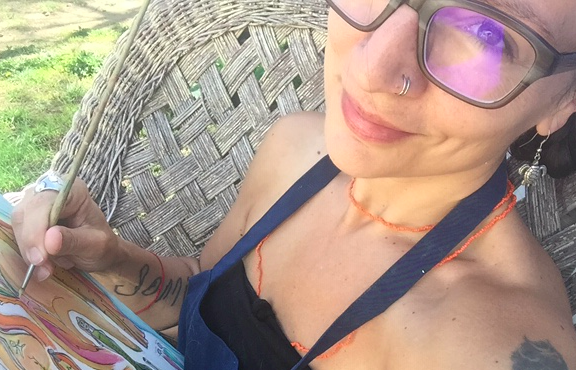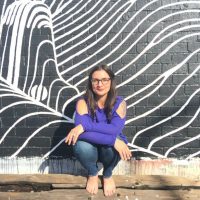Too often, art-making is seen as reserved for only a few who we deem “natural talent.”
Like so many other creative and physical practices, it is sadly judged and valued solely for its final product, aesthetics, or marketability. These cultural norms keep us from experiencing the wisdom and enlivening that art-making can offer our lives and that our ancestors knew well.
Each art medium has its own specific blessings and challenges that lend themselves as powerful communication tools. Paint is lush and also undeniably messy, often unforgiving, and hard to control. That’s why the process of painting can so easily mimic our reactions and responses to life. Working with paint affords us the opportunity to explore and navigate messiness without any seriously damaging consequences. The process of making art provides profound richness if I stay present and practice confronting my perfectionism.
While living in stunning and soulful Oaxaca, Mexico last year, I decided to explore my painting practice with support and take a week-long acrylic paint workshop. It’s not easy to choose which one to take. Oaxaca is brimming with opportunities to learn. I chose a studio and teacher that seemed aligned with my values.
“How did you know it was aligned?” Well, this studio didn’t seem to have any agendas or overstated promises. They used language of inclusivity, sharing, and exploration. The art in their collection exhibited expression through several mediums, techniques, and styles. And from the first session, I felt a healthy balance of support and instruction that didn’t intrude upon my independence. I mention this to you firstly because without these values your creative process may not be safely nurtured and what you can glean from your painting experience may be different from the one I am sharing with you.
Entering the workshop reminded me that it’s okay to feel clumsy. No, correction. Clumsiness is required when I’m trying to grow or try something new. My painting process thrived from embodying a beginner’s mind each day. I needed to “let go” of my past experiences—both the ways that I had painted and been taught before.
I wanted to change my relationship with the paint and myself. Often feelings of shame and frustration would arise. I wanted my skills to be further along and was saddened that I had not been consistently devoted to my painting practice in the recent past. I had to continuously remind myself that I was practicing, not auditioning for some hidden audience inside myself. Regardless of whether you identify as an artist or not, learning and progression requires humility and acceptance. Therefore, each day I needed to be more open, forgiving, and awkward than what was comfortable for my ego.
My second and perhaps greatest lesson: let the paint be the paint! Let the paint flow and be itself. Stay curious about how it behaves. I realized that most often I would become frustrated with my painting because I wanted the paint to perfectly mimic the pencil drawing that it was based on or, worse, the image in my head. This expected conformity and perfectionism brought disappointment. It reminded me that I was often living with force and fantasy instead of curiosity and joy.
Your underlying sketch is a guide. It gives you parameters to work within and push against. However, the best-laid plans will still require flexibility with what arises to reassess and simply greet yourself kindly where you are. I experienced much more gratification and calm when I reminded myself that the painting was for my exploration and that the end result did not have to be appreciated by anyone else or sold. It was for an intimate conversation with myself. I could enjoy the present moment if I didn’t attach it to the end result and dump a bunch of expectations on it.
My painting experience also offered stunning lessons in exploring opposites. There are many inherent considerations. For example, there is wet and dry, fat and lean, light and shadow, opacity and transparency. I had to find balance in my light touch and my stronger application. I had to evaluate how much water was too much and not enough. These lessons in finding the “middle way” felt relative to finding balance in my personal boundaries. I was reminded that healthy boundaries are a dance and rarely static or fixed. And that often what seems like opposites are only different points on a spectrum of experience.
I started to enjoy the flow of the colors running like rivers and streams on the canvas. Yet I still wanted to remember my original sketch and intentions of the piece. I had to exercise varying perspectives to stay aligned with my intentions.
If I stayed too close to the canvas, I couldn’t see the whole picture. I had to make choices. If I only wanted to let the colors flow and enjoy only that part of the process, I would have a different end result. Yet, I wanted to honor my sketch and needed to work with the paint and learn new skills for the desired effects. These creative forks in the road are the contemplative part of the process that mirrors our lives. It’s not that one choice is necessarily wrong but each choice may offer one thing and perhaps exclude another. Or the dance between two things may yield yet another unexpected result.
For example, during our quarantine it is the dance between grief and gratitude that is most relevant for me. I cannot stay in only one of those seeming polarities. I must dance with both. I cannot overanalyze. I must allow myself to feel both and stay in movement with both. Like in painting, my shifting perspective serves.
This leads to one of my final painting life lessons to share with you: keep going.
Layers create depth and we are nothing without our mistakes. I have too many unfinished paintings because I didn’t ask for help or temporarily abandoned my beloved practice out of frustrations with my own limitations. Art-making or paint in itself is not magic. Practice allows magical experiences, unexpected choices, and profound communication with ourselves, others, and our environment to emerge and be realized. Painting with reverence, cautiousness, and playfulness can coexist and therefore, I can live in this manner in uncertain circumstances.
I think all these lessons surface because paintings are visual reminders of something bigger. They are artifacts of an intimate process. At its core, painting allows us to gain wisdom about the movements between our hearts and our body/hands/work, our minds and our hearts, our light and our shadow, our stories and our souls. And maybe painting mimics the dance between water and the earth and the water in our bodies.
Ultimately my painting workshop in Oaxaca reminded me that the more I practice painting in a safe space, the more my intentions and skills are aligned with what I want to and can create and offer in my communities when it is time to share. If we allow the creative process to be reserved for only a few, we lose the beautiful wisdom and energy that these communication tools provide for our lives. If this is what emerged in a week-long taller, I remain wonderfully curious and grateful about my lifelong practice and yours.
~








Read 6 comments and reply